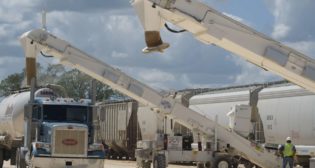
Reports: MRL Reopens Railroad Bridge 28 Days After Collapse
Written by Marybeth Luczak, Executive Editor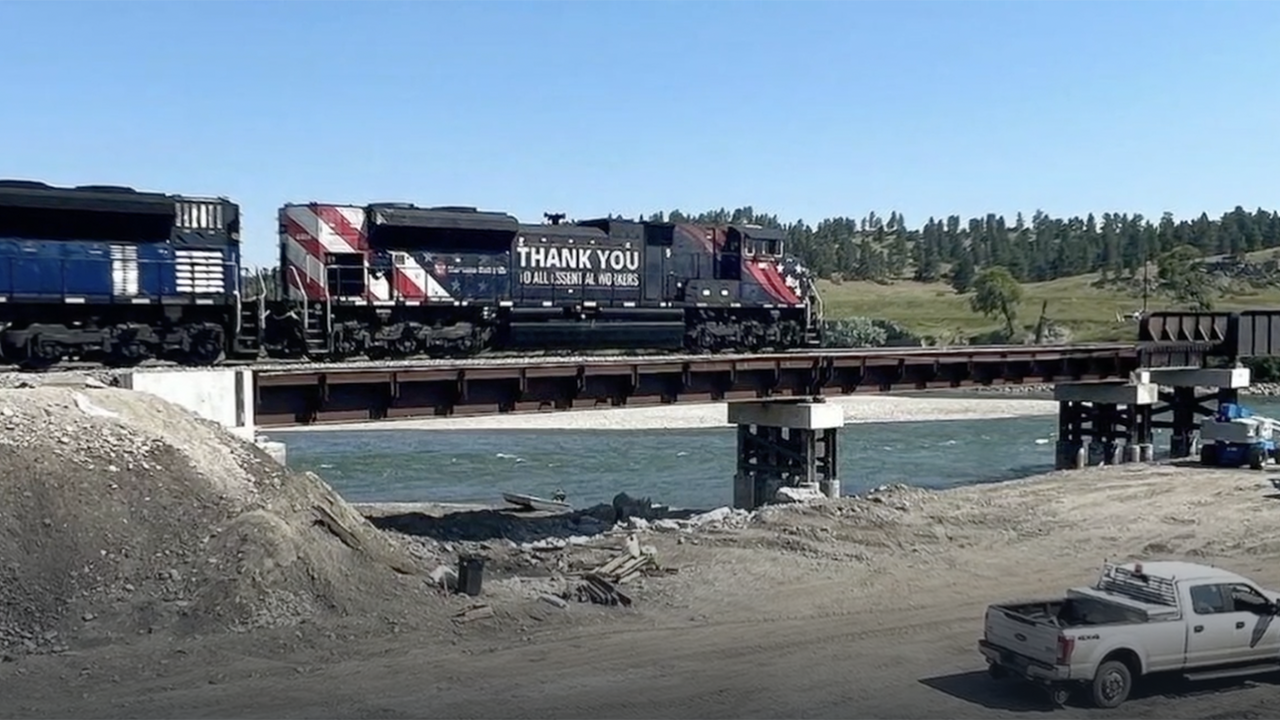
(Screen Grab of image from KTVQ of Billings, Mont., report on July 23.)
Montana Rail Link (MRL) has resumed traffic over the Twin Rivers Railroad bridge in Stillwater County, Mont., which on June 24 collapsed, sending one of the regional’s trains, hauling hot asphalt and molten sulfur, into the Yellowstone River below. MRL took the lead on cleanup efforts and the Federal Railroad Administration (FRA) is heading an investigation into the incident.
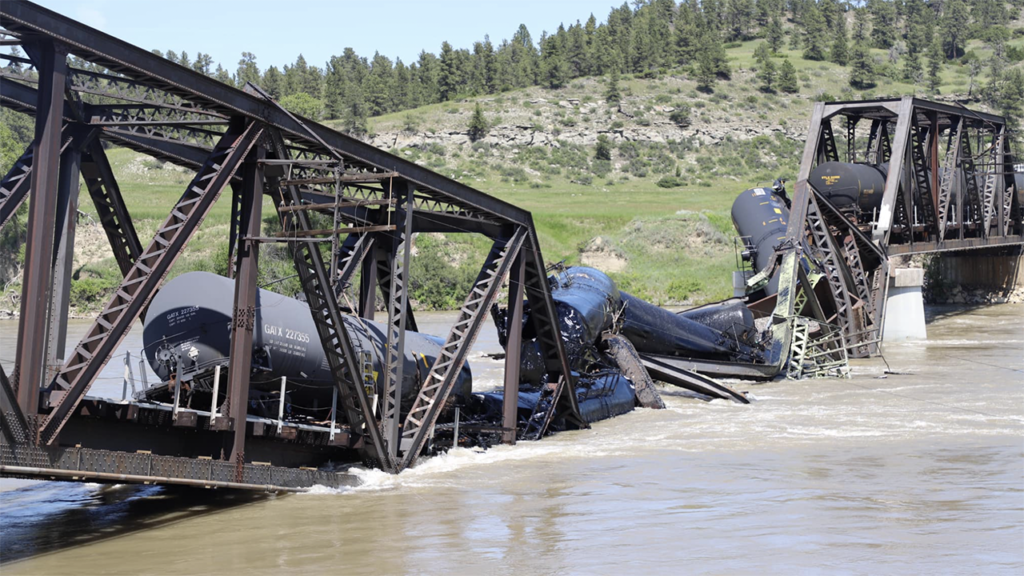
The train crew was safe and no injuries were reported due to the incident, which took place near Columbus, some 40 miles west of Billings. A total of 17 cars derailed, with 10 cars entering the river. The 17 affected railcars contained sodium hydrosulfide, asphalt liquified petroleum, molten sulfur and scrap metal. The 10 cars that impacted the river contain asphalt liquified petroleum, molten sulfur and scrap metal.
“The Environmental Protection Agency previously estimated up to 250 tons (227 metric tonnes) of oil product entered the river from six asphalt binder tank cars,” according to a July 21 Associated Press report. “Agency spokesperson Beth Archer said Friday [July 21] that officials still were determining a final figure.”
MRL crews began initial work on bridge construction July 4. MRL spokesman Andy Garland told KTVQ of Billings, Mont., that the first train crossed the newly constructed bridge on July 22.
“Montana Rail Link has resumed operations with the completion of bridge construction efforts at the site of the June 24th derailment near Reed Point,” Garland said in a statement to the news outlet. “Significant progress was made over the last week of construction. Construction work was completed ahead of initial estimates, allowing service to officially be restored 28 days post outage. As normal train traffic resumes, crews and contractors will remain on site to remove all equipment and material utilized throughout the process and continuing to restore the area. The safety of these crews, our employees, and members of the public remains our top priority as train service is restored.”
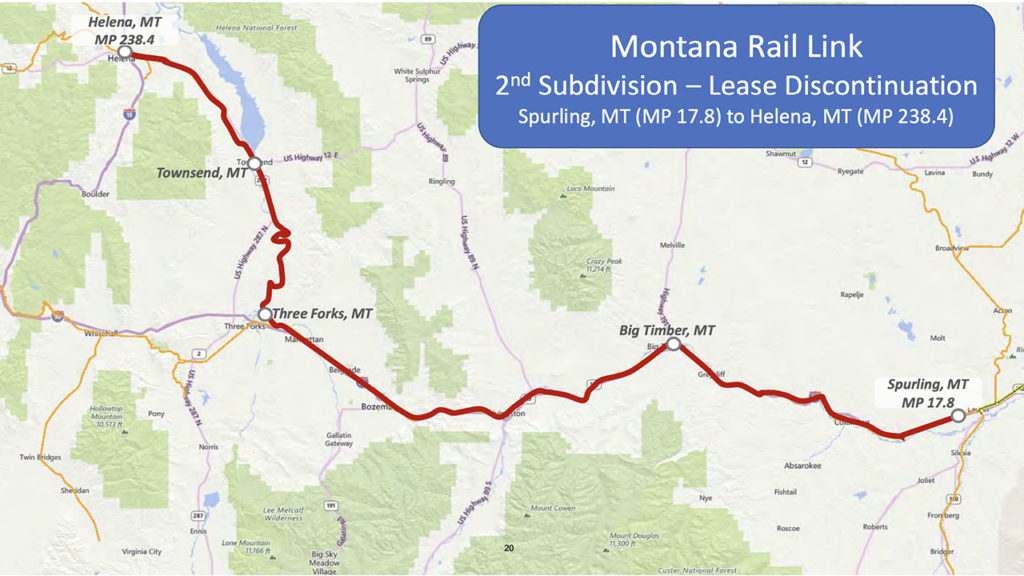
Investigation Under Way
An FRA spokesperson told Railway Age on June 26 that it was “leading an investigation into the cause of the derailment” and “has been and will continue to work with Montana Rail Link, local officials, and the Environmental Protection Agency on the ground as part of this ongoing investigation.” The spokesperson said, “It’s important to note that it is the bridge owner’s responsibility to inspect their bridge. As part of FRA’s investigation, we have requested and will thoroughly review a copy of recent bridge inspection reports for compliance with federal Bridge Safety Standards (49 CFR Part 237).”
The bridge is owned by BNSF, but MRL has maintained it since 1987, according to the Class I railroad. MRL began leasing BNSF lines between Huntley, Mont., and Sandpoint, Idaho, at that time and will continue to do so until the lease concludes in January 2024. BNSF will then resume operational control and infrastructure maintenance, the Class I told Railway Age.
“The railroad bridge is inspected twice a year and the most recent inspection was performed in May, [MRL’s Andy] Garland said,” according to a June 26 Associated Press report.
The Associated Press noted that “the Yellowstone saw record flooding in 2022 that caused extensive damage to Yellowstone National Park and adjacent towns in Montana. The river where the bridge collapsed flows away from Yellowstone National Park, which is about 110 miles (177 kilometers) southwest. Robert Bea, a retired engineering professor at the University of California Berkeley who has analyzed the causes of hundreds of major disasters, said repeated years of heavy river flows provided a clue to the possible cause.
“‘The high water flow translates to high forces acting directly on the pier and, importantly, on the river bottom,’ Bea said Saturday [June 25]. ‘You can have erosion or scour that removes support from the foundation. High forces translate to a high likelihood of a structural or foundation failure that could act as a trigger to initiate the accident.’
“An old highway bridge that paralleled the railroad bridge—together, they were called the Twin Bridges—was removed in 2021 after the Montana Department of Transportation determined it was in imminent danger of falling.”
On July 24, an FRA spokesperson told Railway Age that the investigation is “active and ongoing,” and its “focus remains on the cause of derailment, as well as understanding the structural failure. EPA remains the lead on environmental cleanup and remediation.”
Background on Cleanup Efforts
“Transloading of the sodium hydrosulfide car nearest the river has been completed successfully and the car will be re-railed and moved to a secure location,” MRL said in a statement released late June 25 to KECI of Missoula, Mont., an NBC affiliate. “This process entails moving the contents from one rail car to another rail car or truck. We are aware of reports of globs of asphalt appearing down river that may be associated with the derailment and we will proactively investigate and sample this material. Water quality sampling is being performed by a contractor on behalf of Montana Rail Link with oversight by Montana DEQ and EPA. Preliminary results do not show petroleum hydrocarbons or sulfur impacts to water quality. Water quality testing will continue until the cleanup is complete and at this time there are no known risks to public drinking water. Sprint and its contractors are on site to repair a damaged fiber line associated with the incident. As of this afternoon [June 25], National Transportation Safety Board (NTSB) officials have also arrived onsite to assist in reviewing the incident.
“We are appreciative of Governor Gianforte and the First Lady’s visit to the site this afternoon, along with the messages received from members of Montana’s Congressional delegation. Additional equipment, including a large crane, will be brought on site later this evening to assist with construction and remediation efforts. Site cleanup and remediation will be an extensive process, but we are committed to working closely with all of our local, state, and federal partners to perform all required work in a safe and efficient manner.”
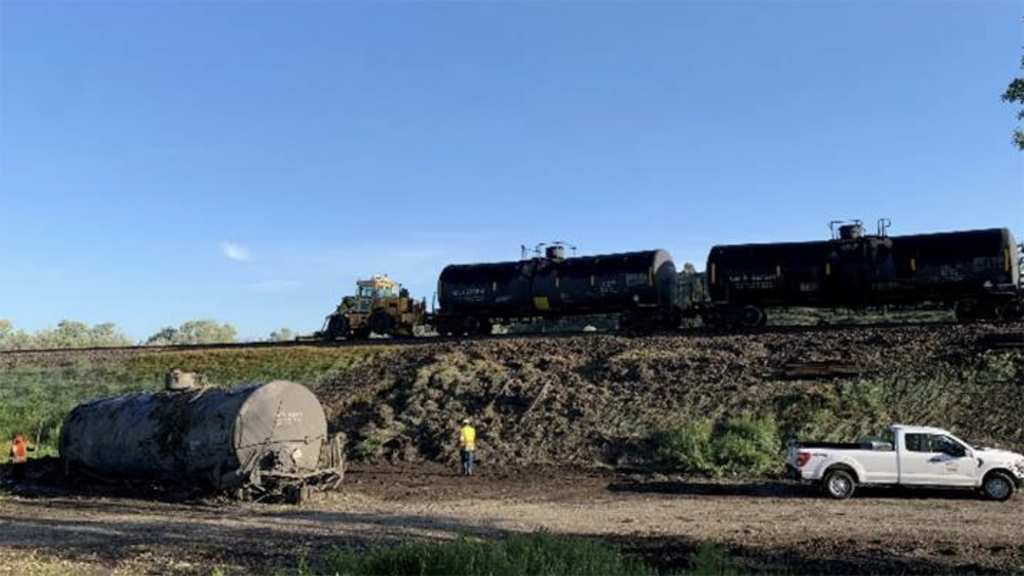
Late on June 26, the following statement was issued by the Unified Command, comprising representatives from the Stillwater County Disaster and Emergency Services, Montana Department of Environmental Quality, U.S. Environmental Protection Agency and MRL, who are jointly managing and directing incident response activities:
“On Sunday [June 25] evening and Monday [June 26] morning, progress was made on the removal of railcars that have impacted the Yellowstone River and the Twin Bridges Railroad bridge in Stillwater County, Montana, however a lot of work remains. The contents of both railcars containing sodium hydrosulfide, that were located on the west side of the bridge, have been successfully transferred into stable railcars and moved to safety. Eight railcars on the eastern side of the bridge that did not reach the water have been removed. Five of these railcars contain asphalt and three contain fertilizer. Today [June 26], construction teams removed the cars containing fertilizer and one asphalt car leaving four asphalt cars remaining on the eastern side of the bridge. These will be removed as cleanup efforts continue. Ten cars are in the river, six contain asphalt, three contain molten sulfur and one contains scrap metal. The condition of these cars, including two that are submerged is a key unknown in the plan to remove them from the water. A dive team has arrived on scene to gather more information about the situation below the surface. Contractors and a large crane have been brought onsite to stabilize and remove these cars from the river. MRL is currently working with their unions and BNSF to find alternative traffic routes to limit supply chain disruptions.
“Asphalt globules have been detected downstream on the banks and in the body of the Yellowstone River. This solid waste is not water soluble and is not anticipated to impact water quality. Water quality testing results from Saturday show no detectable levels of petroleum hydrocarbons or sulfur and samples continue to be taken and analyzed. At this time, there are no known risks to public drinking water or private drinking water wells.”

On June 27, the Unified Command announced that crews were able to access and remove the first impacted car from the river. That car contained asphalt. Additionally, riprap was brought onsite to construct a causeway, or a stable path, it said, to assist car assessment and removal. The Unified Command also shared that crews safely disassembled the west segment of the bridge.
“Communities on the BNSF Railway routes from Laurel to Shelby and Glendive to Snowden should expect increased rail traffic for the next several weeks because of the service interruption on the Montana Rail Link network,” the Unified Command said June 27. Affected counties include Yellowstone, Golden Valley, Wheatland, Judith Basin, Cascade, Teton, Pondera, Toole, Dawson, Richland and Roosevelt.
On June 28, the Unified Command reported that crews had safely removed a second asphalt car from the river, and construction of the causeway continued to improve access to the cars in the river. “Additional site preparation work on the east side of the river will also improve access to the railcars,” the Unified Command said. “Once this work is complete, crews will begin transferring the contents of the asphalt cars on the east side of the bridge, that have not entered the river, into stable railcars and moving them to a safe location.”
Representatives from Montana Fish, Wildlife & Parks (FWP) have visited the site. The Unified Command reported that according to FWP, “Montana Fish, Wildlife & Parks has implemented an emergency closure on portions of the Yellowstone River in Stillwater County following the partial bridge collapse and train derailment. The Yellowstone River is closed to all public access one mile upstream and 2.5 miles downstream of the Twin Bridges Road railroad bridge in Stillwater County until further notice. River and access site closures are subject to change based on condition assessments and needs of emergency response agencies.”

On June 29, the Unified Command confirmed that crews had safely removed three additional cars from the river: two asphalt cars and a sulfur car. The five cars that remained in the river included two asphalt cars, two sulfur cars, and a car filled with scrap metal.
“Construction to the causeway continues, enabling the crews onsite to continue their work to access and remove the remaining cars,” the Unified Command reported. “Work is being performed on the eastern side of the bridge for contractors to begin transferring the contents of the remaining loaded asphalt cars on the eastern span of the bridge.”
Daily water and air-quality testing and monitoring continued to be conducted at 10 downstream locations and three upstream reference locations. “Results thus far continue to show no detectable levels of petroleum hydrocarbons, and downstream sulfur levels are consistent with those being reported at the upstream sampling locations,” the Unified Command reported. “At this time, there are no known risks to public drinking water or private drinking water wells.”
The Unified Command said that “the cause of the derailment is unknown” and remains under investigation.
On June 30, crews safely removed two more asphalt cars from the river, according to a Unified Command report. In total, seven of the 10 cars that entered the river have been removed, including all six of the impacted asphalt cars. Work continued on the removal of two remaining molten sulfur cars and the car filled with scrap metal. Construction crews also continued preparing the eastern side of the bridge to transfer asphalt product from three upright asphalt cars that did not enter the river to stable railcars, the Unified Command said. Crews continued to assess the safest approach to remove a fourth asphalt car that was resting on the edge of the bridge and had not entered the water, it noted.
The Unified Command said its representatives and the environmental assessment team would be on the river on the afternoon of June 30 “investigating and developing a plan to physically remove asphalt material. Members of the public are encouraged to continue reporting sightings of any asphalt material they observe and avoiding contact, when possible, to bare skin. Preliminary reports from the National Oceanic and Atmospheric Administration (NOAA) show that asphalt material will continue be seen further downstream in increasingly smaller sizes.”
The Unified Command said reopening agricultural headgates and irrigation sources continued to be a focal point, and it aimed to minimize impact to local agricultural producers as much as possible.

On July 1, the Unified Command reported that the asphalt car resting on the eastern span of the bridge was lowered into the water before being moved to the west bank of the river for removal. While crews were completing this work, there was an asphalt material release. “Initial assessments indicate the release was minimal based on the amount of material believed to still be remaining in the impacted car,” the Unified Command said. It noted that crews were also able to remove one of the additional impacted molten sulfur cars from the river. Only two cars remained in the river: a molten sulfur car and the scrap metal car.
MRL continued to coordinate on alternative routes for train traffic to minimize impacts of the derailment on customers and the nation’s supply chain, according to the Unified Command. Additionally, the Brotherhood of Locomotive Engineers and Trainmen (BLET) and MRL signed an agreement allowing the regional’s train crews to run trains from Laurel to Great Falls and Great Falls to Shelby.
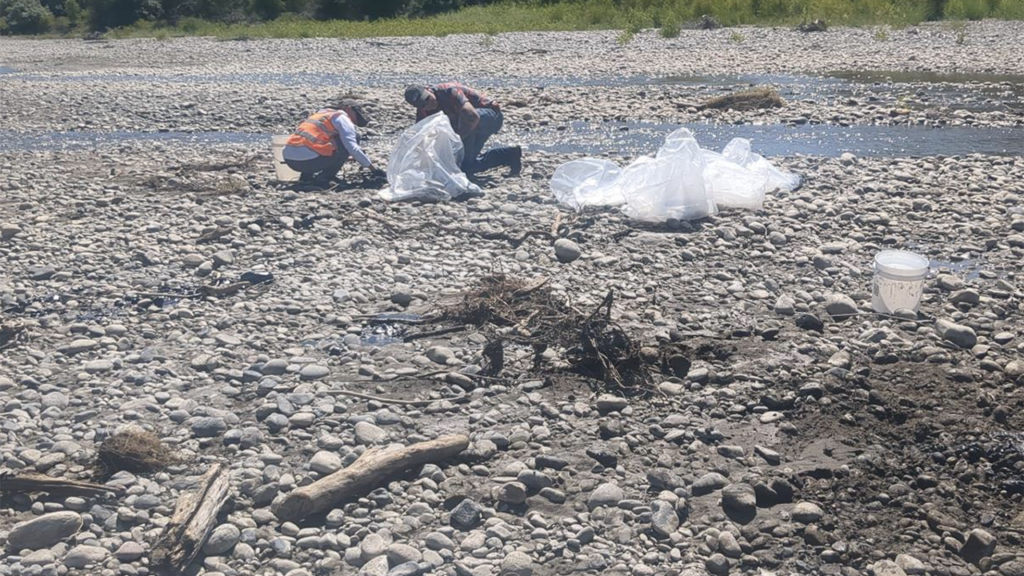
On July 2, notifications to agricultural irrigation ditch users began stating that they could reopen their irrigation canals, which had been advised to be closed as a safety precaution, according to the Unified Command. Shoreline teams would continue to monitor those ditches. On the same day, the Unified Command received a report of an oiled bird, which was later found by the Oiled Wildlife Care Network. Oiled Wildlife Care teams continued their assessment of the riverbanks.
The Unified Command on July 3 confirmed that the last railcar in the river, containing sulfur, along with the bridge steel from the middle span had been removed. Teams finished transferring the product from the three remaining asphalt cars on the eastern span of the bridge into stable railcars for removal. Work to remove the now empty cars remaining on the eastern span of the bridge continued.
“Our efforts have been focused on removing the railcars from the river and assessing downstream impacts,” said Columbus Fire Department Chief Rich Cowger. “We are turning our attention to cleaning affected areas along the Yellowstone River.”
Some 1,500 pounds of asphalt material was collected July 2.
According to the Unified Command’s July 3 report, all railcars were out of the river and the potential release of asphalt materials was no longer a concern. Environmental teams focused efforts on continued downstream assessment and adding additional resources to the cleanup. There were additional boats and personnel deployed to remove asphalt material from the riverbanks, according to the Unified Command. On-water crews removed more than 7,000 pounds of asphalt material during July 3 operations. Additionally, MRL was running traffic and serving customers across its system not impacted by the derailment.
On July 4, the Unified Command confirmed that all railcars involved in the derailment had been safely removed from the bridge and surrounding area. Additional construction to the causeway was performed and a crane pad was constructed. With no cars remaining, the asphalt source has been removed from the river, mitigating the threat of additional product release, according to the Unified Command, which said that it was now concentrating on expanded shoreline assessment and cleanup efforts.
Crews began initial work on bridge construction July 4.
According to the Unified Command’s July 5 report, additional resources continued to be brought onsite to assist with bridge reconstruction. All impacted railcars involved in the derailment, it said, had been moved to a dedicated staging area where they will be cleaned and processed for safe disposal. Additionally, daily water quality testing continued to show “no detectable levels of petroleum hydrocarbons, and downstream sulfur levels remain[ed] consistent with those that have been reported at upstream sampling locations.” Due to these consistent results as well as “no known risks to public drinking water or private drinking water wells, water quality testing will no longer be performed daily,” the Unified Command said.
More than 23,000 pounds of asphalt material had been recovered as of the evening of July 5.

On July 6, cleanup crews continued expanding asphalt material collection efforts. According to the Unified Command, crews had been focused on the first four river miles downstream of the site. The assessment area extended 240 river miles downstream with the goal to cleanup as much asphalt material as retrievable, while limiting the impact to the ecosystem, it said.
“An initial rapid assessment of observed asphalt material began on June 25, the day after the derailment. In rapid assessments, teams observed asphalt material 110 miles downstream,” the Unified Command said. “The teams continue[d] with detailed assessment and are flagging locations of recoverable asphalt. These assessment teams have completed reviewing and tagging locations needing cleanup 16 miles downstream and are continuing to target the cleanup efforts on the most impacted areas as they move downstream.” Environmental crews look daily for impacted wildlife, it added. Total confirmed impacted wildlife: three (one bird and two garter snakes).
According to the Unified Command, MRL continued to make efforts to serve customers and limit impacts to the supply chain as much as possible. “MRL train crews are assisting in the movement of trains from Laurel to Great Falls and Great Falls to Shelby in order to aid in traffic re-routing and supply chain continuity,” Unified Command reported. “Bridge construction activity and preparation is ongoing as MRL continues to work with all federal, state and local agencies involved in the process. While there is no timeline currently available regarding completion of bridge construction, work efforts will continue with the goal of returning to normal operations as soon as possible, while keeping the safety of MRL employees, responders and community members as the top priority.”

On July 7, cleanup crews continued expanding asphalt material collection efforts. The total number of on-water personnel: 150. Approximately 35,000 pounds of asphalt material had been recovered as of the evening of July 6, according to the Unified Command. “Typically at oil spills, not all material that enters the water is recoverable,” it reported. “This is why source control, in this case removing the railcars with material still in them, was a high priority. Regardless of the amount spilled in the river, the priorities remain to remove as much material as feasible, reducing the physical risk to animals, and to minimize the impact of the cleanup on the ecosystem.”
The Unified Command team continued to gather information about the total amount of asphalt material that entered the river. Roughly one million pounds of asphalt material was in the six railcars that entered the river. “Two railcars are still relatively full, two are half full and two are relatively empty,” the Unified Command said. “Initial rough estimates for the maximum amount thought to have entered the river is 500,000 pounds.” After the recovered railcars are cut open and the material can be removed and weighed, Unified Command said it would have a more accurate estimate on the amount of asphalt material that entered the river.
![“This record growth [in fiscal year 2024’s third quarter] is a direct result of our innovative logistic solutions during supply chain disruptions as shippers focus on diversifying their trade lanes,” Port NOLA President and CEO and New Orleans Public Belt (NOPB) CEO Brandy D. Christian said during a May 2 announcement (Port NOLA Photograph)](https://www.railwayage.com/wp-content/uploads/2024/05/portnola-315x168.png)
